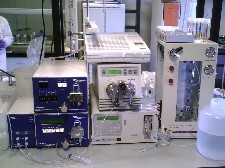Flow Field-Flow Fractionation (FlFFF)
FlFFF is a chromatography-like technique used to separate and characterize polymers and particles ranging from 1 nm to100 mm. It is similar to chromatography in that is uses a thin flow channel (like a column) within which the channel flow (solvent) carries the sample through the channel.
 The Postnova F1000 model Universal Fractionator FFF efficiently separates and characterize macromolecules, colloids and nanoparticles in the range 0.001-0.45 µm according to their diffusion coefficient from which a hydrodynamic diameter or molar mass can be calculated. The analysis time can vary between 20 and 60 min for each run, according to the size range of the sample.
The Postnova F1000 model Universal Fractionator FFF efficiently separates and characterize macromolecules, colloids and nanoparticles in the range 0.001-0.45 µm according to their diffusion coefficient from which a hydrodynamic diameter or molar mass can be calculated. The analysis time can vary between 20 and 60 min for each run, according to the size range of the sample.
Particles of varying sizes (more correctly diffusion coefficients) are separated by their interaction with a parabolic velocity gradient within the channel and a secondary force (a secondary flow in this case) applied perpendicular to the channel flow. Particles are pushed towards a so-called accumulation wall and the concentration gradient set up encourages back diffusion into the channel. The smallest (most diffusive) particles diffusive into the highest velocity flow and are eluted first.
Split-flow Thin-cell fractionation (SPLITT)
Split-flow Thin-cell fractionation (SPLITT) is a technique for separating colloids (< 1 mm) and particles (> 1 mm) and has some similarities to FlFFF, in that separation occurs in a thin, laminar flow with a force applied at right angles to the flow (Gravity in this case). A binary separation occurs, similar to filtration, but no membrane is used and therefore membrane artefacts are removed and the separation is expected to be minimally perturbing to natural aquatic colloids.
Cross Flow Ultra-Filtration (CFUF)
Cross Flow Ultra-Filtration (CFUF) is a technique employed for the isolation and concentration of the sub-micron range particles from large volumes of fluid. It is most commonly used in the range of microfiltration, ultrafiltration, and nanofiltration. The main advantage of CFF system is its potential ability to quickly process large volumes of water (up to 13 L/min) with the removal of artifacts such as concentration polarisation and clogging compared with traditional frontal filtration.